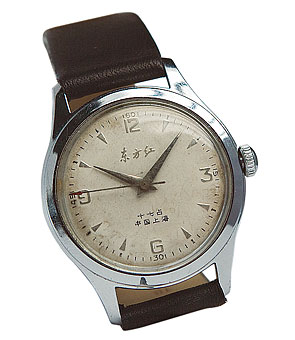
Revolutions in time: Production of cheap mechanical watches meant that millions of Chinese could own timepieces
European watchmakers are competing for lucrative slices of the China market, but not everyone in the world's fastest-growing economy is interested in a Chopard or a Blancpain. One small clique of collectors prefers to concentrate on homegrown brands — and they don't mean upscale makes. Their obsession is for mechanical watches produced by communist factories from the 1950s to the 1970s, and stems from a mixture of historical curiosity and opportunism. It's an area of collecting that has been barely explored, with no price barriers to entry.
Hong Kong native Joel Chan is one of the pioneers. When not scouring the curio and antique shops of Shanghai, the 38-year-old collector frequents online forums such as those at Watchuseek.com to satisfy his time-consuming but affordable craving. The website's Chinese Mechanical Watches forum is a learned gathering where Chan and his fellow aficionados politely compare and praise each other's recent discoveries, discuss dial typography and intricate case engravings, and generally provide encouragement to other members of their growing band. Chan also writes a blog at micmicmor.blogspot.com, and generously — in fact surprisingly, given the secretive nature of many collectors — shares locations of the dusty Shanghai outlets where he adds to his collection of more than 700 Chinese watches. If you want to see what the fuss is about, pay a visit to Mr. Rong, whose quaint and rarely troubled store is at 378 Changle Road in the city's Xuhui district. Or try Mr. Xie's dealership at 425 Fang Bang Zhong Road.
Chan admits that a love of his country partly spurred his original interest in old Chinese timepieces. A chance meeting with a Japanese collector left him perturbed by the thought that overseas enthusiasts were snapping up China's horological history. "I was jealous of them," he admits, and immediately set about studying the subject. Today, novice collectors regularly approach Chan with their questions, and a book is in the pipeline.
The earliest, state-produced watches in China, Chan says, came from the Shanghai Watch Factory, founded in 1955 — six years after the declaration of the People's Republic. Rare handmade 1956 Shanghai prototypes of the Heping (meaning "Peace") and Dong Fang Hong (or "East is Red") models are the favorites in Chan's extensive collection. They were based on a classic Swiss movement, and Chan acquired them from private collectors for a few hundred dollars each.
Of the first 100 or so pieces produced by Shanghai, only 12 passed the modest quality standards, which required the watches to neither gain nor lose more than 120 seconds a day. But these unreliable prototypes, Chan explains, provided the basis for the mass-produced A581 — launched in July 1958 and adorning many Chinese wrists until its discontinuation in 1967. Millions of A581s were made, which means that today they are relatively easy to pick up in Shanghai curio stores from about $15 (variations in dial color and casing style will affect the price). Chan is also a fan of the A623, launched in 1963 and the first Shanghai watch with a calendar function. The A623 was not available to the general public but only provided to high-ranking government and military officials — a fact that lead to its nickname of "the minister watch." The very first piece made was strapped upon the wrist of China's then Premier Zhou Enlai, who wore it until his death in 1976. The trusty timepiece is now on display at the National Museum of China at Beijing's Tiananmen Square. In 1964 a special edition of the A623 was released to commemorate the successful testing of China's first nuclear device.
Chan snapped up his A623 in an online auction for just under $150 — underscoring the fact that early communist-era Chinese mechanical watches are within the financial reach of almost anyone. "Even many rare models can still be found for [around] $75," Chan says. To be sure, some pieces occasionally fetch impressive sums (a 1955 Shanghai Watch sold at auction for over $15,700 in 1996), but for the moment no one is talking about the investment value — only the pleasure of getting your hands on a quaint piece of revolutionary history.